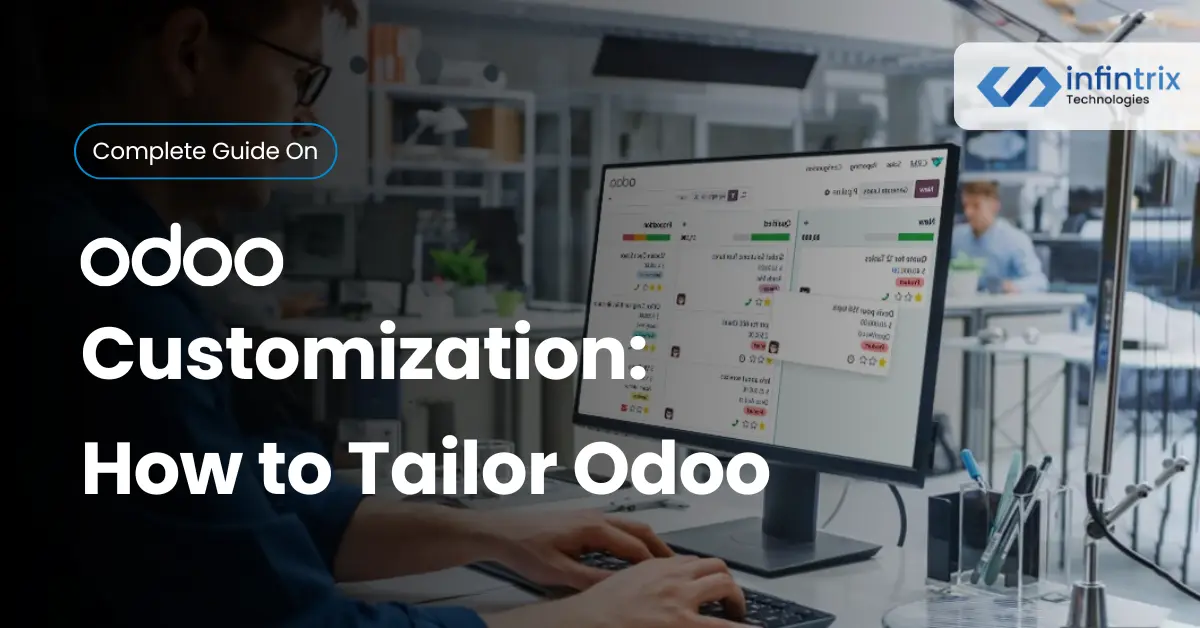In today’s fast-moving business environment, one-size-fits-all software rarely works. Every organization—whether it’s a manufacturer in Lahore, a retailer in Karachi, or a growing service firm—runs on its own mix of processes, approvals, and reporting habits. That’s where ERP systems like Odoo come in.
Odoo’s strength lies in flexibility. It’s a complete Enterprise Resource Planning (ERP) platform that integrates finance, HR, inventory, CRM, and more into one system. Yet many companies soon realize that the “out-of-the-box” setup doesn’t fully mirror how their business actually operates. That’s when Odoo customization services become essential—helping you tailor modules, automate workflows, and align the platform with your unique business needs.
Understanding Odoo Customization Services
Customization simply means shaping Odoo to fit your organization, not the other way around. For decision-makers, it’s the difference between a system that forces users to adapt and one that supports how your teams already work.
What Does Odoo Customization Actually Mean?
Odoo customization can range from simple configuration—adding custom fields or adjusting form views—to deeper, code-level changes built by an experienced Odoo developer. Using Python and Odoo’s modular structure, developers can modify business logic, design custom modules, or even integrate third-party systems. Both Odoo Community and Odoo Enterprise editions support this flexibility.
When Should Businesses Consider Customization?
- Your standard ERP workflows no longer match real-world processes.
- Employees use spreadsheets or side tools outside Odoo.
- Reports take too long to generate or don’t reflect key metrics.
- You need integration with external platforms like Shopify or QuickBooks.
- Managers struggle to enforce approval chains or automation rules.
Benefits of Customizing Odoo ERP
A properly customized Odoo system delivers clear, measurable benefits:
- Scalability – easily adjust as your company grows.
- Efficiency – automate repetitive tasks and reduce errors.
- Visibility – get accurate dashboards and decision-ready reports.
- ROI – better alignment between system behavior and business goals improves return on investment.
That said, the best customizations start with understanding—not coding. A thoughtful discovery phase ensures changes truly support your business processes and deliver long-term value.
Types of Odoo Customization Services Available
Not every company needs full-scale development. Some just require tweaks; others need entire modules. Knowing what’s possible helps you choose the right scope and budget.
Module-Level Customization (Sales, Inventory, HR, CRM, etc.)
You can customize Odoo modules to fit your operations. For example, manufacturers may add multi-stage quality checks in the Inventory app, while service firms can add client-specific billing rules in Accounting. These targeted improvements keep processes consistent across departments.
Workflow and Process Automation Customization
Automation is where Odoo truly shines. Common examples include:
- Auto-creating invoices when delivery is validated.
- Sending reminders for unpaid quotations.
- Triggering manager approval for expenses above a limit.
- With Odoo workflow automation, routine tasks run smoothly without human follow-up.
UI/UX Customization for Better User Experience
Good design drives adoption. Custom dashboards, simplified menus, and intuitive layouts help non-technical staff work confidently in the system. Whether built through Odoo Studio or direct code, thoughtful UI adjustments ensure teams actually use the ERP.
Integration Customization with Third-Party Tools
Few businesses run on Odoo alone. Third-party integration connects your ERP with tools employees already rely on.
| Integration Type | Example Tool | Key Benefit |
| eCommerce | Shopify | Sync products, orders, and inventory |
| Accounting | QuickBooks | Consolidate financial records |
| Collaboration | Google Workspace | Centralize communication and file sharing |
These integrations eliminate duplicate entry and bring all data into one trusted platform.
The Odoo Customization Process: Step-by-Step Overview
A structured approach keeps ERP customization efficient and risk-free. Below is how most certified Odoo partners handle a professional project.
Step 1 – Business Needs Assessment
Before touching any code, the consultant studies how your teams actually work. Key questions: What slows daily operations? Which reports matter most? A clear checklist of goals, workflows, and dependencies forms the foundation for accurate customization.
Step 2 – Technical Analysis and Solution Mapping
Next comes aligning those requirements with Odoo’s existing modules. Some gaps can be solved by configuration; others need Odoo custom development. This mapping ensures every modification supports a defined business objective.
Step 3 – Custom Development and Testing
Development starts once the blueprint is approved. Typical tasks include:
- Extending models using Python and XML.
- Adding new business logic or approval layers.
- Ensuring version compatibility across Odoo Enterprise and Odoo Community.
- Running functional and integration tests to validate performance.
Step 4 – Deployment, User Training & Ongoing Support
After testing, changes are deployed to production. Teams receive hands-on training and clear documentation. Reliable partners provide post-launch support—fixing bugs, refining workflows, and guiding future upgrades—so your ERP continues to evolve with your business.
Odoo Customization vs. Odoo Configuration — What’s the Difference?
One of the most common questions during ERP implementation is where configuration ends and customization begins. Both are valuable, but they serve different purposes depending on your business goals and technical needs.
What Is Configuration in Odoo?
Configuration uses Odoo’s built-in tools to set preferences, define users, and enable modules—no coding required. You might create new user roles, update workflows, or activate accounting features. It’s ideal for smaller teams or businesses whose processes align closely with Odoo’s out-of-the-box structure.
When Customization Becomes Essential:
Once you hit the limits of configuration—say, when your approval process involves five levels or your reports need complex calculations—customization steps in.
| Feature | Configuration | Customization |
| Code Involvement | None | Requires Python or XML coding |
| Cost | Low | Depends on project scope |
| Flexibility | Moderate | High — fully tailored logic |
| Upgrade Impact | Minimal | Requires version testing |
In short, configuration sets up Odoo; customization shapes it around your specific requirements.
Common Odoo Customization Challenges and How to Avoid Them
Even the best ERP platforms face pitfalls when planning isn’t done right. Recognizing them early saves time, cost, and frustration.
Poor Requirement Analysis & Miscommunication: The top mistake is skipping discovery. Without detailed process mapping, developers may build what’s requested—not what’s truly needed. Involve key users early and validate every requirement before development begins.
Over-Customization Leading to Upgrade Issues:
Too much customization can make future upgrades difficult. To prevent this:
- Stick to Odoo’s modular structure.
- Avoid altering core files.
- Document all custom modules clearly.
Lack of Testing & Version Control: Testing isn’t a final step—it’s a continuous one. Use staging environments and Git-based version control to ensure every change remains stable and traceable.
Best Practices for Successful Odoo Customization
The best ERP projects follow discipline and structure, not just technical talent.
Define Clear Requirements Before Development:
A strong requirement document is the backbone of success. It clarifies who uses each feature, what data they need, and what results are expected.
Use Official Odoo APIs and Follow Odoo Standards:
- Leverage Odoo’s ORM for database operations.
- Avoid hardcoding; rely on model inheritance.
- Secure sensitive data through access controls.
- Ensure new modules comply with Odoo upgrade policies.
Test Incrementally, Not at the End:
Small, iterative testing helps catch logic errors early. It’s far easier to adjust a single process now than overhaul a full workflow later.
For example, Infintrix Technologies, a certified Odoo Partner in Pakistan, applies structured version control and modular development for each customization—ensuring smooth upgrades and long-term stability for their clients.
Why Choose a Certified Odoo Partner for Customization
ERP customization isn’t just about code—it’s about business continuity. That’s why partnering with experienced professionals matters.
Benefits of Working with a Certified Odoo Partner
- Proven technical expertise in Odoo Community and Odoo Enterprise.
- Compliance with Odoo’s official development and security standards.
- Clear accountability and quality assurance.
- Faster delivery using pre-tested frameworks and reusable components.
How to Evaluate the Right Customization Partner
Look for these traits when selecting your ERP consultant:
- Verified certification and active Odoo contributions.
- Transparent pricing and clear communication.
- Strong track record with case studies or industry projects.
- Reliable post-launch maintenance and version upgrades.
Companies like Infintrix Technologies, an Odoo Partner in Pakistan, exemplify these qualities—helping businesses across industries implement reliable, future-ready ERP systems customized to their exact needs.
FAQs About Odoo Customization Services
What types of Odoo customizations are most common?
Most businesses focus on sales, inventory, and accounting modules, plus automation of approval workflows and customized reporting dashboards.
How long does Odoo customization take?
Simple configurations may take a few days; more complex projects involving multiple modules or integrations can extend to several weeks.
Can I customize only one module or multiple at once?
Yes, you can modify one module at a time—or several together for cross-department automation. Your partner can guide you on project phasing.
How much do Odoo customization services cost in 2025?
Costs vary by complexity, module count, and developer expertise. Certified partners like Infintrix Technologies provide detailed estimates tailored to your business scale and timeline.
Will customizations affect future Odoo upgrades?
Not if done correctly. Version-safe practices and modular coding protect your customizations during upgrades to newer Odoo Enterprise or Community versions.
Conclusion:
A successful ERP isn’t about forcing your team to change habits—it’s about creating a system that works naturally with your workflows. Odoo customization allows you to do exactly that.
Whether you need smarter automation, cleaner reports, or industry-specific workflows, tailoring Odoo to your processes ensures sustainable growth and efficiency. For many companies, partnering with an experienced consultant—like Infintrix Technologies—turns that vision into reality with scalable, high-quality solutions built for the long run.

